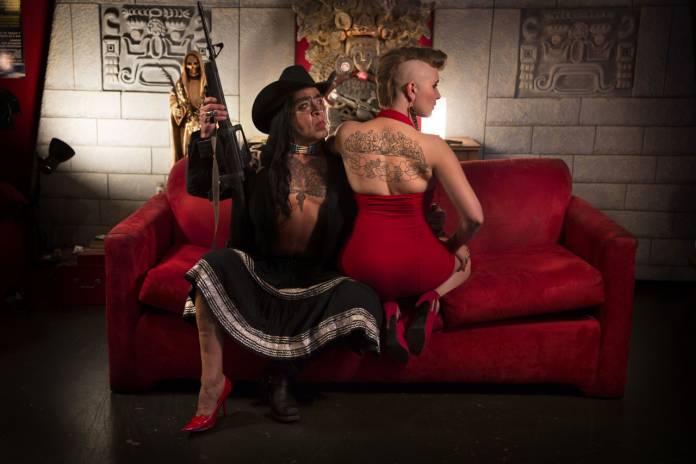MEXICO CITY, MEXICO — Logistically and philosophically, being a trans-border radical performance art troupe is not simple. The Bay Area-based Pocha Nostra troupe, led by San Francisco legend Guillermo Gómez Peña, has been dealing with the financial and artistic challenges of staying relevant on both sides of the U.S.-Mexico border for some time now — and it seems to be getting even more challenging lately.
Despite preparing for an upcoming “tech exorcism” performance at the Fort Mason Chapel, Fri/19, (titled, with usual Pocha exuberance, “Ex Machina 3.0: A Psychomagic Exorism Of The Tech Industry”) and a “Phantom Mariachi Durational Performance,” (Sat/20), Pocha is having some trouble keeping it together on the northern end of the equation. Luckily, there has always been life beyond the Bay for this group.
Last Thursday night in Mexico City, Pocha Nostra took over the lobby of the Museo de Arte Moderno, an undulating, multi-layered space through which the audience ambulated, taking in the works. Pocha member Saul García López lay flat on his back on the ground floor, covered in corn, depicting transgenic Aztec god Xochipilli. In the center of the lobby, Balitronica Gómez Peña mirrored López’s prone position, nude and oiled up to receive 40 acupuncture pins adorned with the paper flags of corporations the troupe saw as plunderers of Mexico. Gómez Peña intoned from an upper level, ceding the mic to Mexican performance artist Felipe Ehrenburg, whose face had been bound onstage save for his distinctive white mustache.
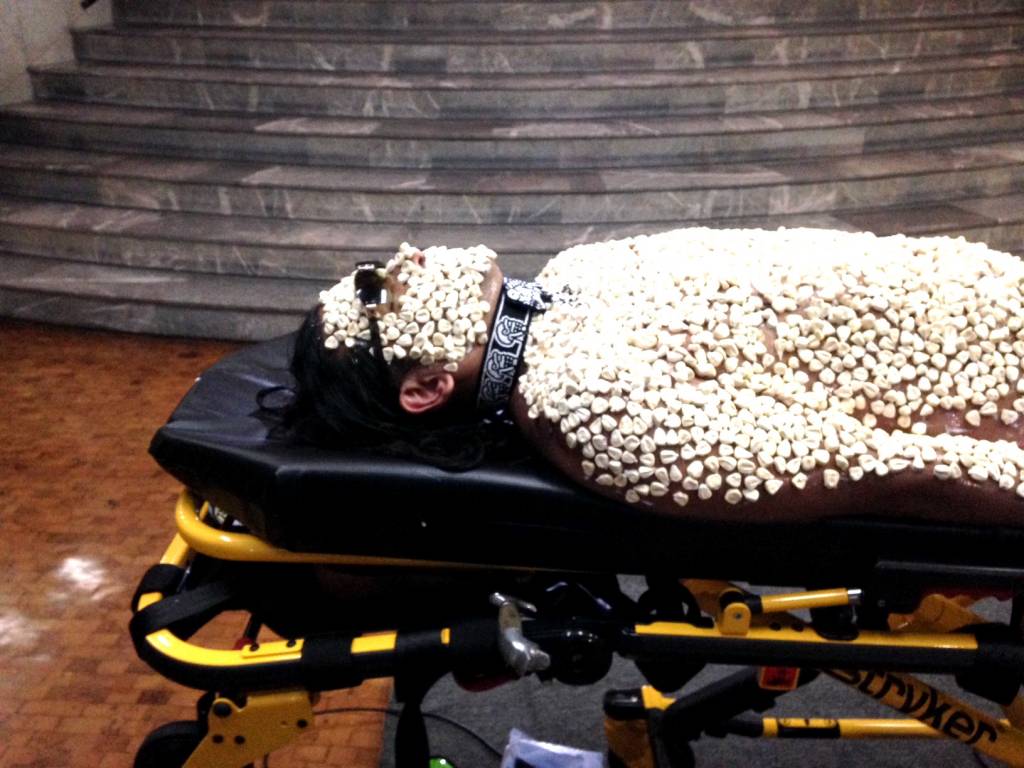
The thematics were Mexican, excavating the institutional sources of pain suffered throughout the country. But much of Pocha Nostra’s identity is formed thousands of miles north in San Francisco, a place where loss of community and space has marked the past year. (Galeria de la Raza, which hosted Pocha Nostra, moved the troupe out of its six-year old studio space last month, which Gómez Peña bitterly protested.)
“The main problem in this city of unbearable sameness that San Francisco has become in the past several years is that two-thirds of the critical arts and activist communities have been forced out of the city,” said Balitronica. (They’re in the middle of a fundraising campaign if you’d like to help the troupe bring its members back together for a Mexico City reunion.)
The current artistic climate in San Francisco has Pocha Nostra members thinking outside the Bay in terms of future projects. In addition to the group’s regular appearances in Europe, Canada and elsewhere, Balitronica has dreams of conducted a workshop series in red America, in the fly-over states that are nonetheless home to scattered queer, brown performance artists. All look forward to spending more time in Mexico, where Gómez Peña’s deceased parents’ house in the northern Nueva Santa María neighborhood serves as the troupe’s southern club house.
On the night of the performance at the Museo de Arte Moderno , the museum’s director Sylvia Navarette announced that in the fall of 2017 the institution will be home to Gómez Peña’s first career retrospective.
We spoke to Guillermo Gómez Peña and his partner Balitronica Gómez Peña about the geographic pulls that Pocha Nostra is currently subject to, and inquired as to their plans in case of a Trumpocalypse.
48 HILLS Balitronica’s acupuncture performance was very visceral that night at the Museo de Arte Moderno. Can you tell me about the piece’s history in the group? Does needle duty rotate among Pocha members? What version of it will you do for SF on Friday?
GUILLERMO GÓMEZ PEÑA We began working with political acupuncture in 2003 as a response to the U.S. invasion of Iraq. We first started working with nude Arab bodies as a metaphor for the wounded territory of the Middle East utilizing 44 needles bearing flags of the countries involved in the much touted “coalition of the willing”… Then in 2004, when the bloody territorial drug wars took Mexico by surprise, we started using flags either of the countries occupied by crime cartels in Latin America or by the states in Mexico controlled by crime cartels. This series of performances has been presented in over 20 different countries and was originally titled Mapa-Corpo or “Body Maps.”
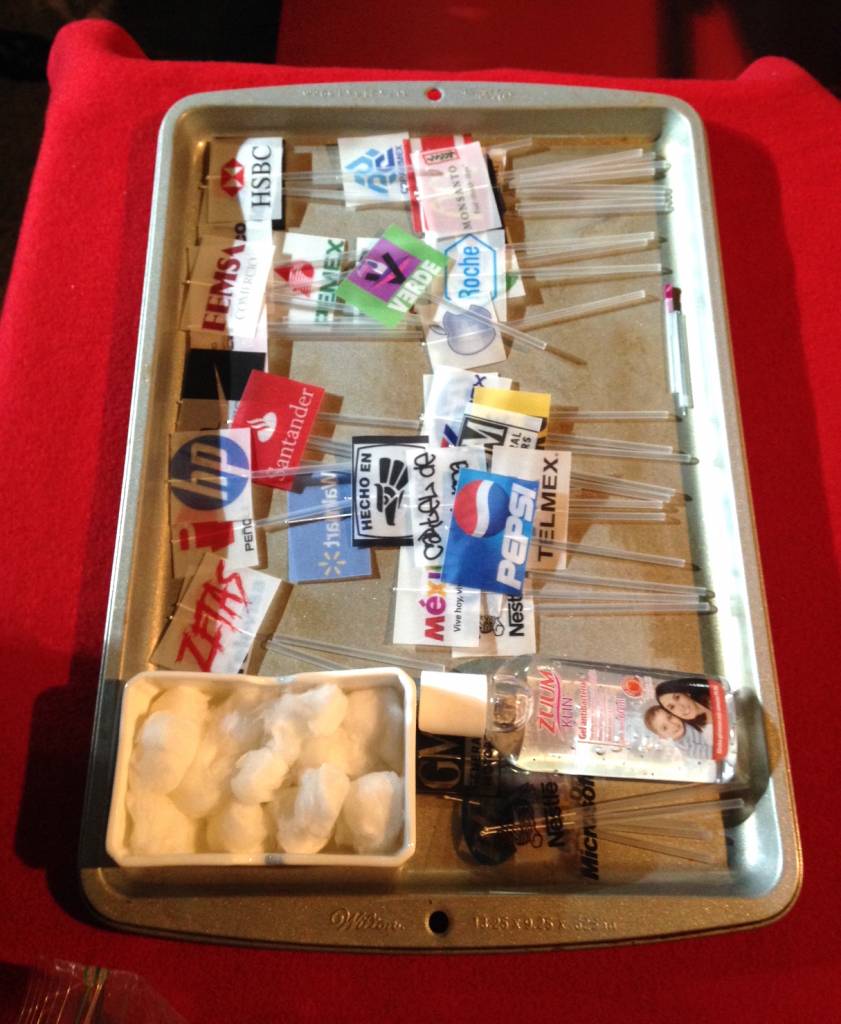
BALITRONICA Most recently, we have been engaged in activism against the tech industries’ displacement of the working class and bohemians of San Francisco. Our project is titled, “Technotopia 3.0.” In this version of Mapa-Corpo, I will have 43 flags inserted into my body (the symbolic number of the students murdered in Ayotzinapa); each flag bearing the logo of the most insidious tech industries in San Francisco; those responsible for turning this ex-bohemian haven into the headquarters and dormitories for the tech industry.
48 HILLS That same night, the museum of Modern Art in Mexico City announced it would host the first retrospective of Guillermo’s work. Guillermo, how does it feel to be at the stage in your career where you have a retrospective? How are you prepping for that show?
GGP It hurts! (He cracks up.) It is a pain in the ass to be considered an “elder” at 60. I hope that this doesn’t mean that my days are numbered as an artist. At the same time, I feel that it’s a victory, that the most important museum in Mexico is recognizing the contributions of performance artists to critical art discourse. Of course, my retrospective is not going to be a typical exhibit. Sylvia Navarette is one of the most adventurous museum directors in Latin America. In dialogue with her, we are planning to create participatory stations throughout the museums where audience members get to become performance artists for an hour or two. We are also exhibiting a selection of some of my most representative artworks in video and large scale photo-performance, as well as artifacts from my personal collection of props and costumes. I hope the “retrospective” is fun, provocative, and proposes a new participatory model for a contemporary art museum, a living think tank of creativity and madness.
48 HILLS In your opinion who’s gonna win the presidential election in the U.S.: If Hilary wins La Pocha Nostra will …
BG If Hillary wins, it’s going to be business as usual in the U.S. A capitalist center right democrat with neoliberal tendencies that pays lip service to social justice and who is in cahoots with the military and financial establishments of the country. Perhaps the minimal existing funding for the arts will remain untouched and we will continue utilizing California and Mexico City as the two headquarters for our troupe, La Pocha Nostra.
48 HILLS If Trump wins Pocha will …
GGP If Trump wins, it will be very exciting and dangerous. Here are some possible scenarios:
The international community — governments and businesses — would boycott the US, and expel our country from international forums, summits, and world conferences. Many countries would consider [Trump] persona non-grata and forbid him to set foot in their territory. At home, there would be dissent in congress and the House of Representatives, both from Republicans and Democrats.
In the best of all worlds, if this sci-fi scenario happens, perhaps our apathetic citizenry would wake up. The U.S. media would also have an epiphany and become a true critical moral force. Cartoonists, comedians, conceptual and public artists, independent filmmakers, satirists, and poets would have even more substantial daily material to work with. I’m already thinking of five new performance art pieces … just in case. Women, blacks, Latinos, and queers worldwide would have yet one more concrete and iconic enemy to mobilize and fight against daily. In brief, we could become a politically and artistically interesting country, not your typical dormant “consumer democracy” we have slowly become in the last years. Are we delusional? Maybe, perhaps. We’re … kidding … however …
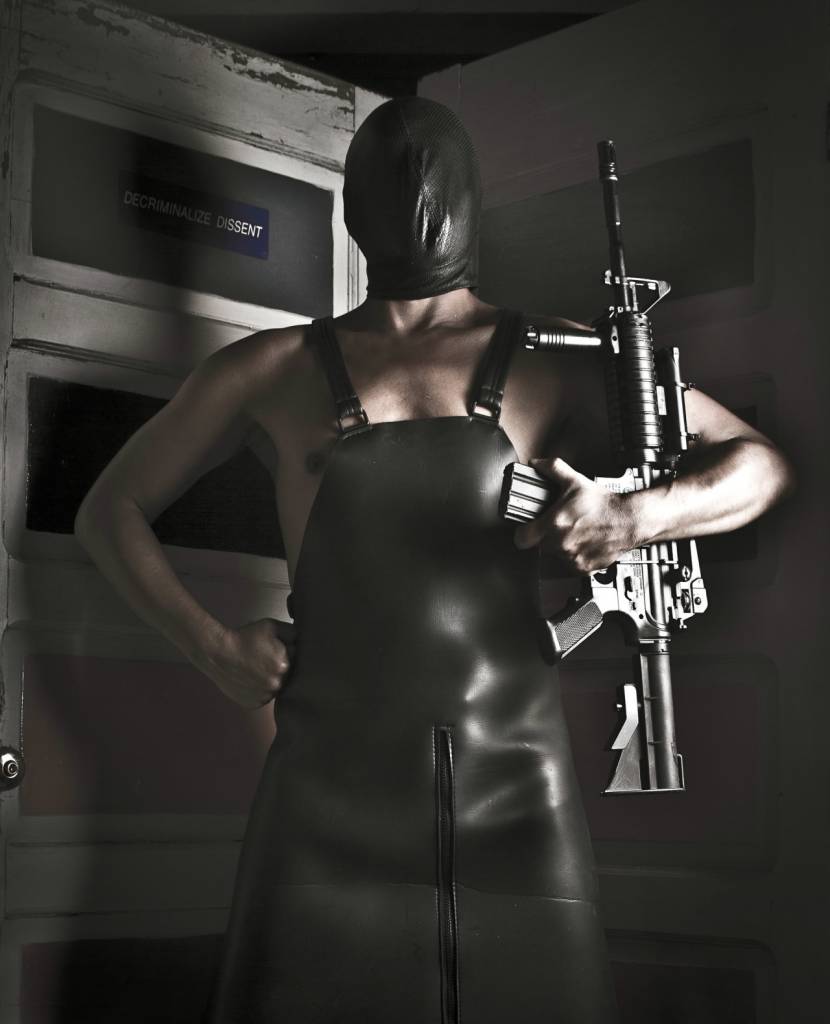
48 HILLS We’ve spoken before about how SF audiences are jaded when it comes to performance art. What tactics do you use before Bay Area performances to make a connection?
BG The main problem in this city of unbearable sameness that San Francisco has become in the past several years is that two-thirds of the critical arts and activist communities have been forced out of the city and now more than half of our audiences are bored techies that are more interested in taking selfies with the “weird performance artists” and texting to their friends that they are actually at a La Pocha Nostra performance art piece than really paying attention and reflecting on the piece.
GGP That’s why our strategies to catch their attention have become radicalized, i.e. The Phantom Mariachi, one of La Pocha Nostra’s most recent inventions (performed by Balitronica): In early 2015 — as the “post-gentrification” era became harder and harder to ignore and more virulent than ever before — La Pocha Nostra began to think of ways to address complex issues facing our Bay Area community in performative, playful and highly visible ways. The persona of the “Phantom Mariachi” was our response. The image features a black Spandex sentai-suited “anonymous” woman (Balitronica) wearing a mariachi hat, high heels, and bearing a barcode that directs onlookers to political statements viewable online.
Other times she holds placards with statements like: “Against the erasure of complex identities, evictions, and suspicious fires.” This bold persona appears as a walking censorship bar. She silently speaks of the devastating erasure of complex identities. She is a symbolic inhabitant of past, present, and future San Francisco. The goal of this real-life super heroine is to inspire people in San Francisco and other cities undergoing similar processes of extreme gentrification to respond with creative and critical commentary to their own local issues. The Phantom Mariachi is relentless. One day you can find her at City Hall or the library taking selfies with the locals, another day she takes tourists by surprise at fisherman’s wharf or appears at a techie conference. We are currently making a film with Chicano filmmaker Gustavo Vazquez titled, “A Day in the Life of the Phantom Mariachi.”
48 HILLS The troupe has always performed on each side of the U.S.-Mexico border, in addition to locations in Europe and other places around the world. What is the main thing that Mexican audiences understand about the border and relations between the two countries that U.S. audiences have a hard time understanding?
GGP I think that Mexicans are fully aware of the U.S. all the time in a way that the Americans aren’t. Mexicans are constantly looking north through media, the Internet, and global pop. But if you browse the newscasts of the U.S. and the daily papers, you rarely find a news item connecting to Mexico. If you are lucky to find one it is always connected to violence, kidnappings, crime cartels, and drugs. Mexico has become “hell on our doorstep.” This mis-encounter of gazes, this permanent misunderstanding between the two countries is a very fertile territory for research for La Pocha. At the same time, we are fully aware that the work we do on one side of the border cannot be reproduced identically on the other side.
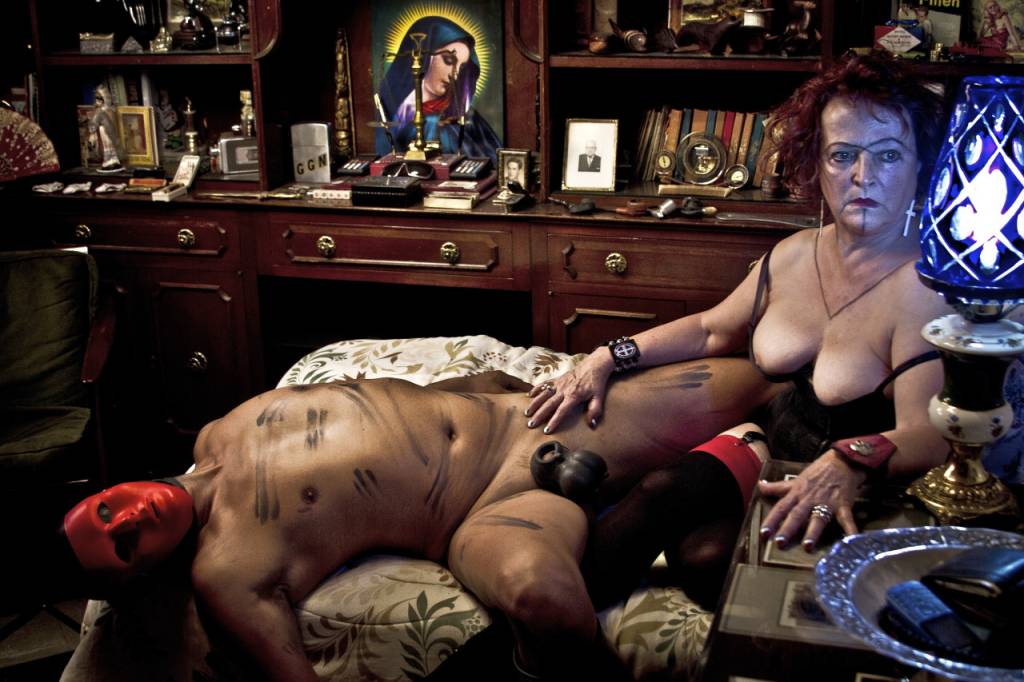
48 HILLS Give me an example.
BG: One of the current live art images that we have been using in the last three years is the image of a huge pig and cow carcasses from a slaughterhouse intervened by the nude bodies of Saul Garcia Lopez and Nayla Altamirano. In Mexico, the title of this piece is “Adam and Eve in Times of War.” In Mexico and other Latin American countries, audiences understand the metaphor very clearly and we have no problem presenting the performance. However, in the U.S., we haven’t found one producer or cultural institution willing to take the risk of producing such a piece. Not only are they afraid of the hardcore live imagery, but also of the extreme health and safety codes of the U.S..
48 HILLS What can we expect from Pocha Nostra for the rest of the year?
BG We will be touring in Mexico, Haiti, the United States, Lima, and Canada. It’s like the Anthony Bourdain show of performance art. Perhaps our most important immediate project is a workshop and performance that will jumpstart the upcoming Cervantino Festival in Guanajuato.
GGP Sounds exhausting que no? It’s our never-ending tour on the edges of Western civilization. Exhausting and exhilarating. That’s how we like it.
48 HILLS Tell me what you still love about San Francisco.
GGP Besides one another, we still love our dear friends and colleagues who have resisted eviction. Every month we throw a huge performance salon in our loft and it becomes a gathering place for all the survivors of the shipwreck: the small communities of sex and political radicals, aesthetic deviants, and formidable activists that used to be a majority in the city.
BG We also love the handful of dive bars that have survived the suspicious fires and the sudden rambunctious sales of the landlords.
GGP The cuisine is still some of the best in the country. Fortunately, we know many bartenders, restaurant owners, and waiters in the Mission area that respect our activist work against gentrification and who treat us like kings and queens when we are in town.
BG At the same time, it becomes harder and harder to walk the streets in city that no longer likes you.
GGP No kiddin’.
EX MACHINA 3.0: A PSYCHOMAGIC EXORISM OF THE TECH INDUSTRY
Fri/19, 8-9pm, free
Fort Mason Chapel, SF
More info here.


